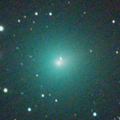
|
It approached to Earth down to 0.08 a.u. in mid December, and it brightened up to 3.4 mag (Dec. 14, Seiichi Yoshida). it looked so large as 3 times of Moon. Now it is fading. But it is very bright as 5.4 mag still now (Jan. 7, Juan Jose Gonzalez). In the Northern Hemisphere, it stays observable in excellent condition. In the Southern Hemisphere, it is not observable until February.
Date(TT) R.A. (2000) Decl. Delta r Elong. m1 Best Time(A, h)
Jan. 12 8 34.20 59 23.6 0.182 1.130 140 5.2 1:10 (180, -4)
Jan. 19 9 2.42 58 15.8 0.225 1.166 140 6.0 1:11 (180, -3)
|
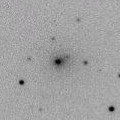
|
Bright new comet. Now it is very bright as 10.2 mag (Jan. 7, Chris Wyatt). It will approach to Earth down to 0.3 a.u. in February. Then it will brighten up to 7 mag and will be observable in excellent condition.
Date(TT) R.A. (2000) Decl. Delta r Elong. m1 Best Time(A, h)
Jan. 12 14 7.12 -22 43.2 1.217 1.338 74 10.2 3:15 (270, 43)
Jan. 19 13 56.34 -21 10.8 0.977 1.311 83 9.6 3:24 (260, 52)
|
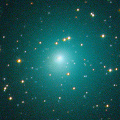
|
Now it is very bright as 9.0 mag (Jan. 6, Juan Jose Gonzalez). It is observable in excellent condition in the Northern Hemisphere. It stays low in the Southern Hemisphere.
Date(TT) R.A. (2000) Decl. Delta r Elong. m1 Best Time(A, h)
Jan. 12 3 23.84 28 35.2 0.844 1.616 124 10.2 21:00 (165, 25)
Jan. 19 3 40.26 27 53.2 0.924 1.658 120 10.6 20:56 (163, 25)
|
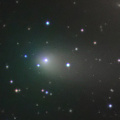
|
Now it is bright as 9.9 mag (Jan. 6, Juan Jose Gonzalez). It stays 9-10 mag until January. In the Northern Hemisphere, it stays observable in good condition for a long time until it fades out. It locates low in the Southern Hemispehre.
Date(TT) R.A. (2000) Decl. Delta r Elong. m1 Best Time(A, h)
Jan. 12 8 34.66 44 6.2 0.830 1.768 154 10.3 1:12 (180, 11)
Jan. 19 8 32.71 45 38.6 0.870 1.807 154 10.6 0:43 (180, 9)
|
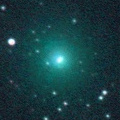
|
Now it is 10.4 mag (Jan. 3, Ken Harikae). It stays at 11 mag until February. In the Northern Hemisphere, it stays observable for a long time until it fades out. But it stays extremely low. It will never be observable again in the Southern Hemisphere.
Date(TT) R.A. (2000) Decl. Delta r Elong. m1 Best Time(A, h)
Jan. 12 19 29.40 22 36.4 2.357 1.791 44 11.2 3:15 (274,-47)
Jan. 19 19 52.14 25 4.1 2.367 1.820 45 11.4 3:24 (268,-45)
|

|
It brightened up to 7.7 mag in June (June 19, Juan Jose Gonzalez). Now it is fading. But it is still bright as 10.6 mag (Dec. 26, Chris Wyatt). In the Southern Hemisphere, it stays observable in good condition for a long time until the comet will fade out. In the Northern Hemisphere, it is not observable for a long time until autumn when the comet fades out down to 16 mag.
Date(TT) R.A. (2000) Decl. Delta r Elong. m1 Best Time(A, h)
Jan. 12 0 41.62 -83 57.6 3.053 2.819 67 11.7 21:00 ( 7, 38)
Jan. 19 1 43.21 -81 11.3 3.067 2.866 69 11.8 20:56 ( 9, 41)
|

|
Now it is 11.9 mag (Dec. 31, Seiichi Yoshida). It stays 12 mag for a long time until spring.
Date(TT) R.A. (2000) Decl. Delta r Elong. m1 Best Time(A, h)
Jan. 12 6 55.74 -20 28.1 2.452 3.240 136 12.6 23:28 (180, 76)
Jan. 19 6 40.53 -21 22.1 2.523 3.280 133 12.7 22:45 (180, 76)
|

|
Now it is 13.7 mag (Jan. 2, Toshihiko Ikemura, Hirohisa Sato). It stays at 12-13 mag for a long time until autumn.
Date(TT) R.A. (2000) Decl. Delta r Elong. m1 Best Time(A, h)
Jan. 12 23 12.92 -3 6.0 2.491 2.119 56 12.8 21:00 ( 94, 11)
Jan. 19 23 26.25 -1 58.9 2.539 2.102 53 12.7 20:56 ( 94, 9)
|
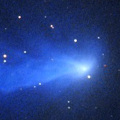
|
Now it is 15.3 mag (Jan. 3, Toshihiko Ikemura, Hirohisa Sato). It will be fading slowly after this. It is observable in good condition in the Northern Hemisphere. In the Southern Hemisphere, it is not observable until summer.
Date(TT) R.A. (2000) Decl. Delta r Elong. m1 Best Time(A, h)
Jan. 12 15 37.09 40 58.9 3.626 3.640 83 13.0 3:15 (228,-12)
Jan. 19 15 44.27 41 21.4 3.626 3.688 85 13.1 3:24 (224, -8)
|
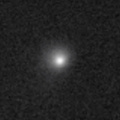
|
Now it is 13.9 mag (Dec. 28, Chris Wyatt). It will brighten up to 10-11 mag in autumn. It will be unobservable temporarily in March.
Date(TT) R.A. (2000) Decl. Delta r Elong. m1 Best Time(A, h)
Jan. 12 1 2.35 -31 10.5 4.420 4.237 72 13.5 21:00 ( 80, 47)
Jan. 19 1 2.45 -29 17.0 4.469 4.195 67 13.5 20:56 ( 80, 42)
|
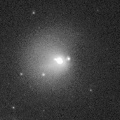
|
Now it is bright as 12.9 mag (Jan. 2, Toshihiko Ikemura, Hirohisa Sato).
Date(TT) R.A. (2000) Decl. Delta r Elong. m1 Best Time(A, h)
Jan. 12 23 5.04 0 35.5 6.250 5.767 56 13.7 21:00 ( 96, 8)
Jan. 19 23 9.21 0 59.9 6.341 5.767 50 13.7 20:56 ( 94, 3)
|
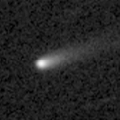
|
Now it is 13.6 mag (Jan. 6, Seiichi Yoshida). It is observable at 14 mag in excellent condition until March.
Date(TT) R.A. (2000) Decl. Delta r Elong. m1 Best Time(A, h)
Jan. 12 11 33.33 -2 38.7 0.963 1.653 116 13.8 3:15 (205, 55)
Jan. 19 11 39.65 -3 51.2 0.928 1.667 121 13.8 3:24 (192, 58)
|
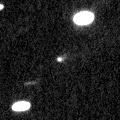
|
Now it is 14.8 mag (Dec. 10, Toshihiko Ikemura, Hirohisa Sato). It is observable in excellent condition in the Northern Hemisphere. It locates low in the Southern Hemisphere.
Date(TT) R.A. (2000) Decl. Delta r Elong. m1 Best Time(A, h)
Jan. 12 11 34.53 28 33.5 1.411 2.135 125 14.2 3:15 (194, 25)
Jan. 19 11 38.27 29 7.3 1.356 2.131 130 14.1 3:24 (186, 26)
|
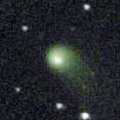
|
Now it is 14.0 mag (Nov. 14, Kunihiro Shima). It stays 13-14 mag until summer. In the Northern Hemisphere, it is appearing in the morning sky. It will appear in late January also in the Southern Hemisphere.
Date(TT) R.A. (2000) Decl. Delta r Elong. m1 Best Time(A, h)
Jan. 12 17 16.42 -12 17.6 4.025 3.252 33 14.1 3:15 (285, -1)
Jan. 19 17 20.27 -13 28.7 3.955 3.252 39 14.1 3:24 (282, 7)
|
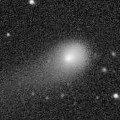
|
Now it is 14.4 mag (Dec. 12, Toshihiko Ikemura, Hirohisa Sato). It will be fading slowly after this. It is observable in excellent condition until spring in the Northern Hemispehre. In the Southern Hemisphere, it will be hardly observable after this.
Date(TT) R.A. (2000) Decl. Delta r Elong. m1 Best Time(A, h)
Jan. 12 11 21.66 41 6.2 4.020 4.693 128 14.4 3:15 (188, 13)
Jan. 19 11 11.01 42 0.7 3.983 4.729 134 14.4 3:20 (180, 13)
|

|
Now it is 14.3 mag (Nov. 30, Seiichi Yoshida). It stays at 14 mag until winter. It is observable in excellent condition in the Northern Hemisphere. In the Southern Hemisphere, it is not observable until summer.
Date(TT) R.A. (2000) Decl. Delta r Elong. m1 Best Time(A, h)
Jan. 12 13 28.45 79 56.4 1.522 2.094 111 14.5 3:15 (188,-27)
Jan. 19 13 14.85 80 38.9 1.544 2.120 112 14.5 3:24 (185,-27)
|
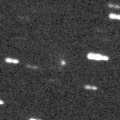
|
Now it is bright as 15.1 mag (Nov. 21, Artyom Novichonok). It stays 14 mag for a long time in 2019. In the Southern Hemisphere, it is observable in excellent condition. In the Northern Hemisphere, it is observable in low sky until early January, but it will be unobservable after that.
Date(TT) R.A. (2000) Decl. Delta r Elong. m1 Best Time(A, h)
Jan. 12 11 20.85 -45 17.5 3.186 3.418 95 15.0 3:15 (325, 77)
Jan. 19 11 14.05 -47 56.9 3.091 3.390 99 14.8 3:23 ( 0, 77)
|

|
Now it is 14.5 mag (Aug. 16, P. Camilleri, H. Williams). It stays 15 mag from 2018 to 2019, and it will be observable for a long time in the Southern Hemisphere. In the Northern Hemisphere, it will never be observable again.
Date(TT) R.A. (2000) Decl. Delta r Elong. m1 Best Time(A, h)
Jan. 12 20 23.13 -63 50.8 4.588 3.926 42 14.9 21:00 ( 24, 19)
Jan. 19 20 43.80 -62 44.5 4.587 3.923 42 14.9 20:56 ( 25, 18)
|
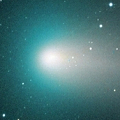
|
It brightened up to 6.8 mag in September (Sept. 17, Seiichi Yoshida). Now it is fading rapidly. It has already faded down to 13.8 mag (Dec. 21, Thomas Lehmann). It is observable in excellent condition in the Southern Hemisphere. It locates low after this in the Northern Hemisphere.
Date(TT) R.A. (2000) Decl. Delta r Elong. m1 Best Time(A, h)
Jan. 12 6 13.18 -34 15.8 1.185 1.890 120 15.2 22:46 (180, 89)
Jan. 19 6 8.54 -32 0.1 1.257 1.954 120 15.6 22:14 (180, 87)
|
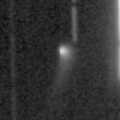
|
Now it is 15.0 mag (Jan. 3, Toshihiko Ikemura, Hirohisa Sato). It stays 15 mag until March. It is observable in excellent condition in the Northern Hemisphere. It is not observable at all in the Southern Hemisphere.
Date(TT) R.A. (2000) Decl. Delta r Elong. m1 Best Time(A, h)
Jan. 12 8 57.16 75 7.5 2.607 3.277 125 15.2 1:38 (180,-20)
Jan. 19 7 43.45 76 33.5 2.625 3.277 123 15.3 23:44 (180,-22)
|
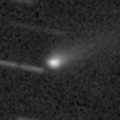
|
It brightened very rapidly up to 13.8 mag in August in 2017 (Aug. 22, Kunihiro Shima). Although it was faint as 16-17 mag in November, it brightened up to 14.7 mag in December (Dec. 12, Toshihiko Ikemura, Hirohisa Sato). In the Northern Hemisphere, it stays observable in excellent condition after this. It stays extremely low in the Southern Hemisphere.
Date(TT) R.A. (2000) Decl. Delta r Elong. m1 Best Time(A, h)
Jan. 12 11 26.42 36 15.8 2.074 2.784 127 15.4 3:15 (190, 18)
Jan. 19 11 25.83 37 33.0 2.050 2.814 132 15.5 3:24 (182, 18)
|
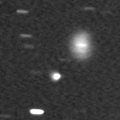
|
Now it is 15.4 mag (Jan. 2, Toshihiko Ikemura, Hirohisa Sato). It is expected to brighten up to 7-8 mag in 2020. It will be unobservable temporarily in April.
Date(TT) R.A. (2000) Decl. Delta r Elong. m1 Best Time(A, h)
Jan. 12 3 2.56 -3 20.0 5.156 5.564 109 15.5 21:00 (144, 53)
Jan. 19 3 0.68 -2 41.2 5.201 5.503 102 15.5 20:56 (136, 49)
|
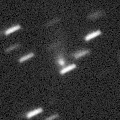
|
It brightened up to 8.7 mag in July (July 18, Marco Goiato). Then it faded down to 12.3 mag in August (Aug. 29, Chris Wyatt). It stays observable in good condition after this while the comet will be fading.
Date(TT) R.A. (2000) Decl. Delta r Elong. m1 Best Time(A, h)
Jan. 12 16 11.84 -19 26.7 3.450 2.865 46 16.3 3:15 (283, 16)
Jan. 19 16 16.71 -18 41.0 3.439 2.950 52 16.4 3:24 (278, 22)
|
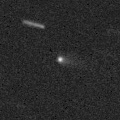
|
Although it was faint as 18 mag until Dec. 10, it suddenly brightened in outburst up to 15.4 mag on Dec. 12 (Dec. 12, A. Heinze). It has already faded down to 17.5 mag (Dec. 31, Toshihiko Ikemura, Hirohisa Sato). It stays observable in good condition for a while.
Date(TT) R.A. (2000) Decl. Delta r Elong. m1 Best Time(A, h)
Jan. 12 1 56.39 6 21.3 2.289 2.614 98 16.3 21:00 (132, 36)
Jan. 19 2 2.42 7 21.1 2.393 2.630 92 16.5 20:56 (129, 32)
|
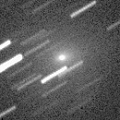
|
It approached to Earth down to 0.3 a.u., and brightened up to 8.3 mag in July (July 22, Juan Jose Gonzalez). Now it is fading. It has already faded down to 19.1 mag (Jan. 3, Toshihiko Ikemura, Hirohisa Sato).
Date(TT) R.A. (2000) Decl. Delta r Elong. m1 Best Time(A, h)
Jan. 12 15 27.01 0 9.2 2.888 2.602 63 16.5 3:15 (260, 14)
Jan. 19 15 24.71 1 21.7 2.827 2.676 71 16.5 3:24 (252, 21)
|
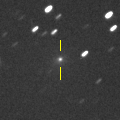
|
Now it is 16.5 mag (Jan. 3, Toshihiko Ikemura, Hirohisa Sato). It is observable at 16.5 mag in good condition in winter.
Date(TT) R.A. (2000) Decl. Delta r Elong. m1 Best Time(A, h)
Jan. 12 4 20.70 11 47.2 0.946 1.772 133 16.6 21:00 (178, 43)
Jan. 19 4 22.27 14 41.8 0.992 1.773 127 16.7 20:56 (172, 40)
|

|
Now it is 16.1 mag (Dec. 12, Toshihiko Ikemura, Hirohisa Sato). It stays 16-17 mag for a long time until 2020. It is observable in good condition in the Northern Hemisphere. It is not observable at all in the Southern Hemisphere.
Date(TT) R.A. (2000) Decl. Delta r Elong. m1 Best Time(A, h)
Jan. 12 11 59.06 72 18.1 7.948 8.450 117 16.6 3:15 (186,-18)
Jan. 19 11 58.04 72 46.8 7.935 8.449 118 16.6 3:24 (183,-18)
|
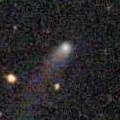
|
It brightened up to 14.7 mag in early 2018 (Jan. 25, Catalina Sky Survey). Now it is fading slowly. Now it is 16.4 mag (Jan. 3, Toshihiko Ikemura, Hirohisa Sato). In the Northern Hemisphere, it stays observable in good condition for a long time until the comet fades out. It is never observable again in the Southern Hemisphere.
Date(TT) R.A. (2000) Decl. Delta r Elong. m1 Best Time(A, h)
Jan. 12 5 50.47 73 6.2 5.501 6.141 126 16.7 22:24 (180,-18)
Jan. 19 5 28.45 72 58.5 5.570 6.166 123 16.8 21:34 (180,-18)
|
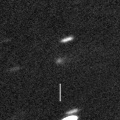
|
Now it is 17.0 mag (Dec. 31, Toshihiko Ikemura, Hirohisa Sato). It stays observable at 17 mag in good condition until February. It locates somewhat low in the Southern Hemisphere.
Date(TT) R.A. (2000) Decl. Delta r Elong. m1 Best Time(A, h)
Jan. 12 8 20.39 23 37.9 1.551 2.522 168 16.8 0:58 (180, 31)
Jan. 19 8 14.44 23 25.6 1.559 2.541 175 16.8 0:24 (180, 32)
|

|
It is expected to brighten up to 10 mag in autumn. Now it is 17.2 mag (Dec. 31, Toshihiko Ikemura, Hirohisa Sato). In the Northern Hemisphere, it stays observable for a long time while the comet is brightening. In the Southern Hemisphere, it it not observable until mid September.
Date(TT) R.A. (2000) Decl. Delta r Elong. m1 Best Time(A, h)
Jan. 12 13 53.71 58 46.1 2.954 3.357 105 17.1 3:15 (204,-12)
Jan. 19 14 2.85 62 3.6 2.848 3.287 107 16.9 3:24 (199,-13)
|

|
First return of a new periodic comet discovered in 2014. It has not been recovered yet. Now it is not detected, fainter than 20.0 mag (Dec. 10, Toshihiko Ikemura, Hirohisa Sato). The condition of this apparition is excelllent. It will brighten rapidly, and will be observable at 15.5 mag in excellent condition in March.
Date(TT) R.A. (2000) Decl. Delta r Elong. m1 Best Time(A, h)
Jan. 12 10 27.59 6 58.9 1.141 1.964 135 17.2 3:04 (180, 48)
Jan. 19 10 29.47 6 52.3 1.065 1.936 141 17.0 2:39 (180, 48)
|
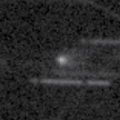
|
Now it is 17.3 mag (Dec. 10, Toshihiko Ikemura, Hirohisa Sato). It is observable at 17 mag in good condition in winter. It locates low in the Southern Hemisphere.
Date(TT) R.A. (2000) Decl. Delta r Elong. m1 Best Time(A, h)
Jan. 12 11 21.20 24 42.2 1.894 2.613 127 17.0 3:15 (191, 30)
Jan. 19 11 19.84 25 51.5 1.869 2.653 134 17.1 3:24 (181, 29)
|
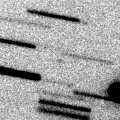
|
Now it is 17.8 mag (Jan. 5, Toshihiko Ikemura, Hirohisa Sato). It is observable at 17 mag in good condition in winter in the Northern Hemisphere. It locates very low in the Southern Hemisphere.
Date(TT) R.A. (2000) Decl. Delta r Elong. m1 Best Time(A, h)
Jan. 12 11 19.08 35 57.3 0.737 1.556 128 17.2 3:15 (189, 19)
Jan. 19 11 24.08 36 47.2 0.734 1.580 133 17.2 3:24 (182, 18)
|

|
Now it is 17.1 mag (Dec. 31, Toshihiko Ikemura, Hirohisa Sato). Fading slowly. It stays observable at 17 mag in good condition until summer.
Date(TT) R.A. (2000) Decl. Delta r Elong. m1 Best Time(A, h)
Jan. 12 11 43.73 6 16.7 9.443 9.933 117 17.2 3:15 (204, 46)
Jan. 19 11 43.66 6 30.1 9.353 9.944 124 17.2 3:24 (191, 48)
|

|
Now it is 17.0 mag (Dec. 12, Toshihiko Ikemura, Hirohisa Sato). It is observable at 17 mag in good condition in 2019. It locates somewhat low in the Northern Hemisphere.
Date(TT) R.A. (2000) Decl. Delta r Elong. m1 Best Time(A, h)
Jan. 12 15 19.28 -14 23.5 4.126 3.734 60 17.4 3:15 (271, 24)
Jan. 19 15 25.88 -14 48.2 4.040 3.741 65 17.3 3:24 (267, 31)
|
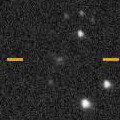
|
Now it is 17.4 mag (Jan. 3, Toshihiko Ikemura, Hirohisa Sato). It stays 16 mag for a long time from 2019 to 2020. It is observable in excellent condition in the Southern Hemisphere. It is hardly observable in the Northern Hemisphere.
Date(TT) R.A. (2000) Decl. Delta r Elong. m1 Best Time(A, h)
Jan. 12 14 15.25 -37 30.8 4.794 4.529 68 17.5 3:15 (290, 47)
Jan. 19 14 16.97 -39 4.8 4.653 4.490 74 17.4 3:24 (290, 54)
|
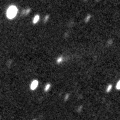
|
Now it is 16.7 mag (Jan. 5, Toshihiko Ikemura, Hirohisa Sato). It is observable in good condition at 16-17 mag in winter.
Date(TT) R.A. (2000) Decl. Delta r Elong. m1 Best Time(A, h)
Jan. 12 7 4.16 2 19.2 2.127 3.067 159 17.4 23:37 (180, 53)
Jan. 19 6 59.75 2 35.4 2.159 3.086 156 17.5 23:05 (180, 52)
|
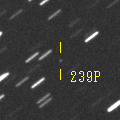
|
Now it is 17.2 mag (Dec. 31, Toshihiko Ikemura, Hirohisa Sato). It is observable at 17.5 mag in excellent condition in January.
Date(TT) R.A. (2000) Decl. Delta r Elong. m1 Best Time(A, h)
Jan. 12 8 12.93 1 36.0 0.698 1.650 157 17.4 0:50 (180, 53)
Jan. 19 8 10.65 0 5.6 0.694 1.652 159 17.4 0:20 (180, 55)
|
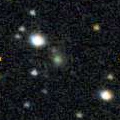
|
Now it is 17.7 mag (Nov. 30, Toshihiko Ikemura, Hirohisa Sato). It is expected to be observable at 5-6 mag for a long time from 2022 to 2023. It will be observable in good condition for a long time in the Southern Hemisphere. In the Northern Hemisphere, it is not observable at the highlight from 2022 summer to 2023 summer.
Date(TT) R.A. (2000) Decl. Delta r Elong. m1 Best Time(A, h)
Jan. 12 17 52.99 51 42.2 12.663 12.472 76 17.5 3:15 (228,-38)
Jan. 19 17 56.26 51 50.3 12.605 12.427 77 17.4 3:24 (226,-33)
|
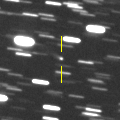
|
Now it is 17.2 mag (Dec. 31, Toshihiko Ikemura, Hirohisa Sato). It was observed at 17 mag in last winter. It will be observable in good condition at 17.5 mag also in this winter.
Date(TT) R.A. (2000) Decl. Delta r Elong. m1 Best Time(A, h)
Jan. 12 4 37.38 4 17.1 7.365 8.082 134 17.5 21:11 (180, 51)
Jan. 19 4 33.19 4 8.3 7.464 8.091 126 17.5 20:56 (174, 51)
|
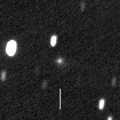
|
Now it is 16.9 mag (Dec. 31, Toshihiko Ikemura, Hirohisa Sato). It is observable at 17.5 mag until January, in good condition in the Northern Hemisphere. It locates very low in the Southern Hemisphere.
Date(TT) R.A. (2000) Decl. Delta r Elong. m1 Best Time(A, h)
Jan. 12 5 57.03 43 53.9 2.961 3.848 150 17.6 22:30 (180, 11)
Jan. 19 5 52.42 43 58.2 3.018 3.860 144 17.6 21:58 (180, 11)
|
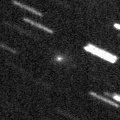
|
First return of a new periodic comet which brightened up to 17.5 mag in 2010. Now it is 17.1 mag (Dec. 31, Toshihiko Ikemura, Hirohisa Sato). It will be fading after this, and will be fainter than 18 mag in late January. It is observable in excellent condition in the Northern Hemisphere. It locates low in the Southern Hemisphere.
Date(TT) R.A. (2000) Decl. Delta r Elong. m1 Best Time(A, h)
Jan. 12 5 44.07 37 38.9 1.197 2.116 151 17.6 22:18 (180, 17)
Jan. 19 5 42.35 37 37.0 1.256 2.140 145 17.8 21:49 (180, 17)
|

|
It was expected to be observable at 17.5 mag in good condition in winter in the Northern Hemisphere. But actually, it is so faint as 21.0 mag (Oct. 5, K. Sarneczky, et. al). It locates low in the Southern Hemisphere.
Date(TT) R.A. (2000) Decl. Delta r Elong. m1 Best Time(A, h)
Jan. 12 5 14.66 34 50.3 2.149 3.024 147 17.7 21:48 (180, 20)
Jan. 19 5 11.27 34 55.7 2.197 3.018 139 17.7 21:17 (180, 20)
|
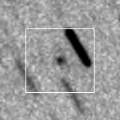
|
Now it is 17.6 mag (Dec. 31, Toshihiko Ikemura, Hirohisa Sato). First return of a new periodic comet which brightened up to 16 mag in 2011. It is observable at 17.5 mag in good condition in winter.
Date(TT) R.A. (2000) Decl. Delta r Elong. m1 Best Time(A, h)
Jan. 12 2 43.30 11 40.3 1.861 2.393 110 17.7 21:00 (148, 37)
Jan. 19 2 48.34 11 34.9 1.932 2.381 104 17.7 20:56 (143, 35)
|

|
Now it is 18.0 mag (Dec. 13, Toshihiko Ikemura, Hirohisa Sato). It stays 17 mag from spring to summer. But it is hardly observable. In the Northern Hemisphere, it is observable only until May. In the Southern Hemisphere, it stays locating extremely low.
Date(TT) R.A. (2000) Decl. Delta r Elong. m1 Best Time(A, h)
Jan. 12 3 38.84 50 56.5 2.233 2.928 126 17.9 21:00 (173, 3)
Jan. 19 3 38.78 50 0.5 2.243 2.877 121 17.8 20:56 (169, 4)
|
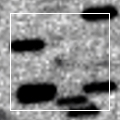
|
Now it is 17.9 mag (Dec. 31, Toshihiko Ikemura, Hirohisa Sato). It is observable at 18 mag in winter.
Date(TT) R.A. (2000) Decl. Delta r Elong. m1 Best Time(A, h)
Jan. 12 6 43.36 21 52.0 2.528 3.498 168 17.9 23:16 (180, 33)
Jan. 19 6 38.62 22 4.7 2.549 3.492 160 17.9 22:44 (180, 33)
|
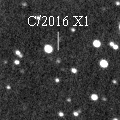
|
Now it is 18.1 mag (Dec. 14, Toshihiko Ikemura, Hirohisa Sato). It is observable at 18 mag in winter.
Date(TT) R.A. (2000) Decl. Delta r Elong. m1 Best Time(A, h)
Jan. 12 7 18.86 4 3.3 6.652 7.594 162 17.9 23:52 (180, 51)
Jan. 19 7 16.55 3 57.7 6.657 7.590 160 17.9 23:22 (180, 51)
|
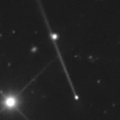
|
Main-belt asteroid. But it shows a straight tail like a comet. Now it is 17.4 mag (Jan. 8, Ken-ichi Kadota). It stays observable in excellent condition until early summer.
Date(TT) R.A. (2000) Decl. Delta r Elong. m1 Best Time(A, h)
Jan. 12 10 48.51 -12 40.8 1.811 2.463 120 18.6 3:15 (187, 68)
Jan. 19 10 47.88 -12 41.6 1.723 2.449 127 18.5 2:57 (180, 68)
|
|
![]()
 C/2018 A6 ( Gibbs )
C/2018 A6 ( Gibbs ) C/2017 B3 ( LINEAR )
C/2017 B3 ( LINEAR ) 21P/Giacobini-Zinner
21P/Giacobini-Zinner C/2018 A3 ( ATLAS )
C/2018 A3 ( ATLAS ) 240P/NEAT
240P/NEAT C/2017 T2 ( PanSTARRS )
C/2017 T2 ( PanSTARRS ) C/2017 T3 ( ATLAS )
C/2017 T3 ( ATLAS ) 243P/NEAT
243P/NEAT C/2018 N1 ( NEOWISE )
C/2018 N1 ( NEOWISE ) 171P/Spahr
171P/Spahr C/2010 U3 ( Boattini )
C/2010 U3 ( Boattini ) C/2016 A1 ( PanSTARRS )
C/2016 A1 ( PanSTARRS ) 59P/Kearns-Kwee
59P/Kearns-Kwee C/2018 W2 ( Africano )
C/2018 W2 ( Africano ) P/2014 C1 ( TOTAS )
P/2014 C1 ( TOTAS ) 164P/Christensen
164P/Christensen 247P/LINEAR
247P/LINEAR C/2014 B1 ( Schwartz )
C/2014 B1 ( Schwartz ) 74P/Smirnova-Chernykh
74P/Smirnova-Chernykh C/2018 F4 ( PanSTARRS )
C/2018 F4 ( PanSTARRS ) 361P/2017 S4 ( Spacewatch )
361P/2017 S4 ( Spacewatch ) 239P/LINEAR
239P/LINEAR C/2017 K2 ( PanSTARRS )
C/2017 K2 ( PanSTARRS ) C/2015 XY1 ( Lemmon )
C/2015 XY1 ( Lemmon ) 159P/LONEOS
159P/LONEOS 369P/2018 P1 ( Hill )
369P/2018 P1 ( Hill ) 232P/Hill
232P/Hill 373P/2018 R2 ( Rinner )
373P/2018 R2 ( Rinner ) C/2018 X2 ( Fitzsimmons )
C/2018 X2 ( Fitzsimmons ) 31P/Schwassmann-Wachmann 2
31P/Schwassmann-Wachmann 2 C/2016 X1 ( Lemmon )
C/2016 X1 ( Lemmon ) (6478) Gault
(6478) Gault![]()










































